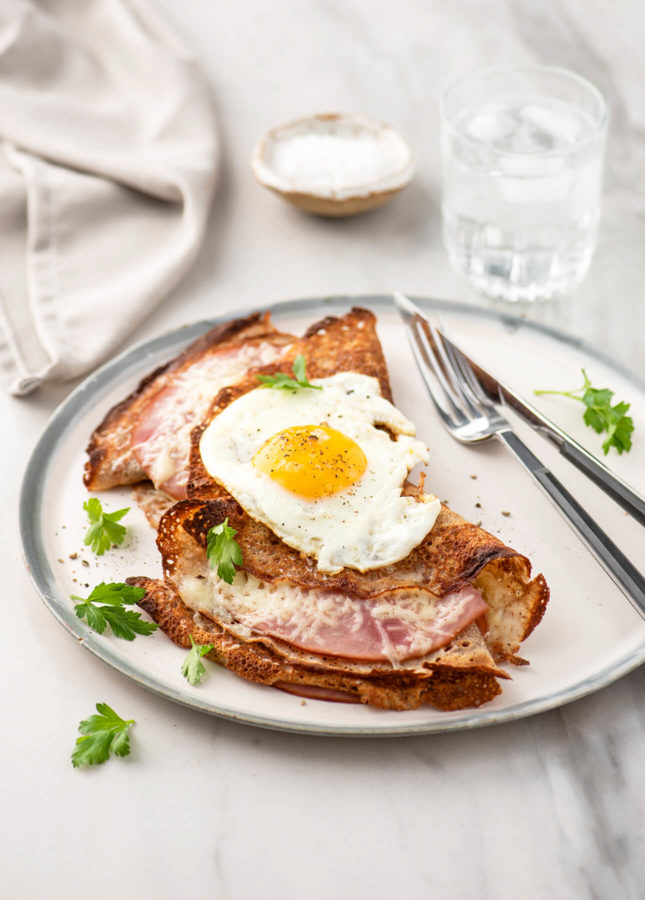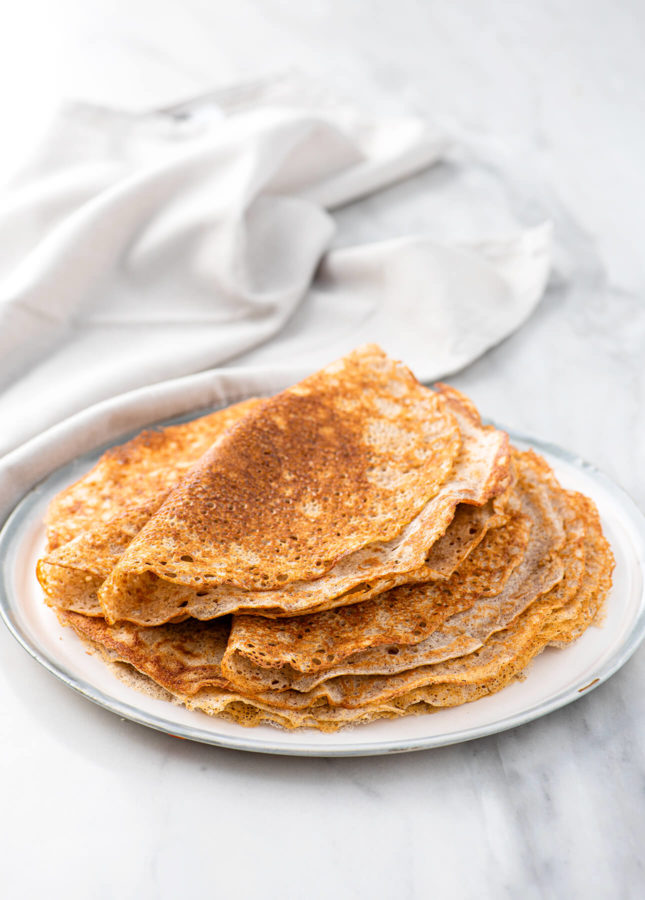- V
- GF
- NS
- DF
- View Recipe Key
Savory Buckwheat Crepes with Egg, Ham, and Cheese (Galettes Complètes)
Savory Buckwheat Crepes with Egg, Ham, and Cheese (Galettes Complètes)
These savory buckwheat crepes are filled with ham and cheese and topped with fried eggs to create an incredibly delicious, fabulously nutritious breakfast or brunch dish.
This post contains affiliate links. Full disclosure is at the bottom of the article.
Some dishes need only to be pronounced to unveil their French origins: quiche, madeleine, and macaron are all delicious tongue-twisters for non-francophones. But one dish has fully entered the English vocabulary, especially that of breakfast and brunch lovers: crêpes.
The large, very thin French pancake has long earned its spot as one of the most popular French dishes worldwide, and it’s easy to understand why:
- Crêpes are versatile: You can make them sweet or savory and enjoy them anytime, from breakfast to dessert.
- Crêpes are make-ahead friendly: You can quickly whip up the batter a few days in advance and cook just the quantity you need when you need them, or you can cook all the crêpes at once and freeze them for months.
- Crêpes are easy to make: Though your first few tries may not result in perfectly circular crêpes, a bit of practice and a pan that is properly oiled or buttered will quickly produce the delicious tender-in-the-center, crisp-around-the-edges result that made crêpes so popular. Read my Helpful Tips below to help you get started.
Crêpes can be made in many different ways. Here, I’m sharing a classic recipe from the northern part of France: buckwheat galettes from Brittany. To say that buckwheat galettes are ubiquitous in Brittany is an understatement, and I must admit that this is one of the things I love most about the region. Whenever I visit, I eat buckwheat galettes and cider for lunch just about every day!
In Brittany, entire restaurant menus are dedicated to crêpes, and savory crêpes are called galettes. The distinction comes from the type of flour used to make the pancakes. Crêpes tend to be smaller in size, prepared with wheat (all-purpose) flour, and served with a sweet filling. Savory galettes are made with buckwheat flour, are quite large in diameter, and are filled with a wide variety of savory fillings, such as meat, eggs, cheese, and vegetables.
But perhaps the queen of all Breton galettes is the galette complète, a pancake filled with ham and cheese and topped with an egg. This is my favorite way to serve buckwheat crêpes, because it truly is “complete”: gooey cheese, salty ham, and a runny egg, all coming together in a tasty, crispy crêpe. It’s easy to make (especially if you make the crêpes in advance!) and super nutritious, yet it eats like a luxurious meal, especially if you serve it with a cup of sparkling cider, as they do in Brittany.
How to Make the Perfect Savory Buckwheat Crêpes
- Make the crêpe batter in advance: Refrigerating crêpe batter allows the gluten to develop in the batter, which results in more flexible, lighter crêpes. You can blend or whisk crêpe batter together up to 24 hours in advance.
- Make sure your batter has the right consistency: Savory buckwheat crêpe batter needs to be loose, which will allow it to easily spread over the surface of the pan, creating thin crêpes. The consistency of the batter should be similar to heavy cream. Because flour textures vary—especially that of buckwheat flour, which can sometimes be quite coarse—you may need to add a bit of milk to your batter to bring it to the right consistency.
- Use a nonstick pan—especially if you’ve never made crêpes before: Crêpe aficionados swear by steel or cast-iron pans, but these work best if you’re an experienced crêpe maker. Cast-iron pans are very heavy, which makes it difficult to swirl the pan and spread out the crêpe batter. And the classic râteau à crêpes, a specialized wooden tool that helps with spreading the crêpe batter evenly, can be tricky to use—some practice is required. Rest assured, however, that no specialty equipment is required to make perfect crêpes: you can cook them in a simple 10-inch (30 cm) nonstick pan. Nonstick pans ensure your crêpes won’t stick—obviously—and result in less waste for novice crêpe makers.
- Preheat your pan on medium heat for several minutes before you get started: The pan must reach a constant, moderate heat to cook crêpes properly.
- Generously oil or butter your pan, even if it’s nonstick: Greasing the pan makes it easier to flip the crêpes, and it also makes them crisper. You should generously grease the pan before you make your first crêpe, and add more oil or butter after every three or four crêpes.
- Pour the crêpe batter quickly and then swirl the pan to spread it all over: If the pan is too hot, the crêpe batter will “seize” too quickly, preventing you from spreading it all over the pan.
- Flip it right: A crêpe will “tell you” when it’s ready to be flipped: its edges will pull up from the pan, and tiny bubbles will appear all over the surface of the crêpe, which will also look dry. A properly cooked crêpe is easy to flip—if the crêpe sticks, it means it’s not ready to be turned over. The second side of a crêpe requires much less time to cook; the crêpe is ready when it’s golden brown, usually in about 1 minute.
- Stack those crêpes high: Stack the cooked crêpes on a plate close to the stove as you go. Once all the crêpes are cooked, you can either use them right away or let them cool completely and then cover with plastic wrap and refrigerate for up to five days. You can also freeze the crêpes in portions you’re planning to use or need, carefully wrapping each stack flat in plastic wrap and then transferring them to a baking sheet to freeze hard. Once the crêpes are frozen hard, you can store them in a heavy-duty freezer bag or in a large container. Freezing the crêpes flat is essential; in my experience, buckwheat crêpes can break when thawed. Save the folding for baking to maximize your chances of keeping your carefully crafted crêpes in one piece.
- Assemble the crêpes the traditional way—or make it your own: Traditionally, Breton galettes are laid flat and garnished with cheese and ham, the edges are folded over by an inch or two to create a square, and an egg is cracked over the top. The heat from the galette is supposed to cook the egg, which remains very runny. In Brittany, sometimes the egg white is barely set, and other times the galette will be finished in the oven to fully set the egg. This process can be stressful and tricky, especially if you’re producing galettes for your whole family.
Here’s how to assemble and serve galettes complètes, stress-free: Garnish the crêpes with cheese and ham, fold them into quarters, and transfer them to a parchment paper-lined baking sheet. Place in a 325°F (160°C) oven for 5 to 10 minutes to melt the cheese and crisp up the crêpes. While the crêpes are baking, heat butter in a large skillet on high and fry the eggs. (If the crêpes are ready before the eggs are done, simply take the baking sheet out of the oven and let them rest while you finish cooking the eggs.) For one serving, set two folded crêpes on a plate, and top with one fried egg. This method provides all the deliciousness of the traditional serving method, ensures that the eggs are properly set, and makes it easier to produce several servings in a breeze.
How to Make Gluten-Free Savory Buckwheat Crêpes
Buckwheat flour is naturally gluten free, and traditional Breton galettes are made with 100% buckwheat flour. However, the lack of gluten in a 100% buckwheat batter can result in crêpes that are more fragile and prone to breakage. This is why recipes often call for replacing one-third of the buckwheat flour with wheat (all-purpose) flour. Crêpes made this way are generally more supple and easier to work with.
However, if you want—or need—to make your savory buckwheat crêpes gluten free, you can either use only buckwheat flour or replace the all-purpose flour with a gluten-free all-purpose flour mix, which contains agents that help substitute the elasticity of gluten and should make the crêpes supple and resistant to folding.

Savory Buckwheat Crepes with Egg, Ham, and Cheese
Ingredients
- For the savory buckwheat crepes
- 1/2 cup 60 g buckwheat flour
- 1/4 cup 31 g all-purpose flour
- 1/4 tsp 1 ml kosher salt, or fine sea salt
- 1 1/4 cups 310 ml milk, preferably whole (3.25 % m.f.)
- 1 egg
- To serve
- 1 1/2 cups 6 oz / 170 g coarsely grated Gruyère cheese, or substitute Swiss, Emmenthal, or Aged Cheddar cheeses
- 6 large thin slices of smoked ham
- 4 eggs
- Oil for frying
- Flaky sea salt and freshly ground black pepper to taste
- Minced chives optional
Instructions
- For the savory buckwheat crepes: In a large bowl, whisk together the buckwheat flour, all-purpose flour, and salt. Add the milk and the egg and whisk vigorously until the batter is smooth. Cover and refrigerate for at least 2 hours, or preferably overnight.
- To make the savory buckwheat crepes, place a crepe pan or non-stick skillet over medium-high heat. Lightly spray the pan with cooking oil or use a piece of paper towel to rub a little butter in the pan. Pour in 1/3 cup (80 ml) of the buckwheat crepe batter in the pan and quickly swirl it to spread the batter over the surface of the pan to create an 8-inch (20 cm) crepe. Let the savory buckwheat crepe brown on one side until crisp around the edge, about 1 minute. Flip the crepe over and cook 1 minute more.
- Transfer the cooked crepe to a large plate and repeat the steps above to make all the crepes, stacking them on top of each other as they are finished. At this point, the crepes can be covered and refrigerated for up to 3 days, or frozen in an airtight container or a heavy-duty freezer bag for up to 1 month.
- To assemble and serve the savory buckwheat crepes: Preheat the oven to 400°F (200°C). Line a baking sheet with parchment paper.
- Set one savory buckwheat crepe flat on a working surface. Sprinkle with 1/4 cup (1 oz / 28 g) of the grated cheese, then top with 1 slice of ham. Fold the crepe in two, then again to create a quarter circle shape. Transfer to the prepared baking sheet. Repeat to assemble all the savory buckwheat crepes. Bake for 5 to 7 minutes, until the edges of the crepes are crispy, and the cheese is melted.
- While the crepes are baking, fry the eggs sunny side up in a very hot oiled skillet, seasoning each with flaky sea salt and freshly ground black pepper.
- Serve two folded savory buckwheat crepes per person and top each serving with 1 fried egg. Garnish with minced chives, if desired, and serve immediately with a green salad.
- Recipe Credit: Adapted from David Tanis, The New York Times.
Did you make this?
Tell me how you liked it! Leave a comment or take a picture and tag it with @foodnouveau on Instagram.
This site is a participant in the Amazon Associates Program, an affiliate advertising program designed to provide a means for the site to earn fees by linking to Amazon and affiliated sites.
If you click on an affiliate link, I may earn advertising or referral fees if you make a purchase through such links, at no extra cost to you. This helps me creating new content for the blog–so thank you! Learn more about advertising on this site by reading my Disclosure Policy.
Author: Marie Asselin





WHAT DID YOU THINK OF THIS RECIPE?
Rate + Review